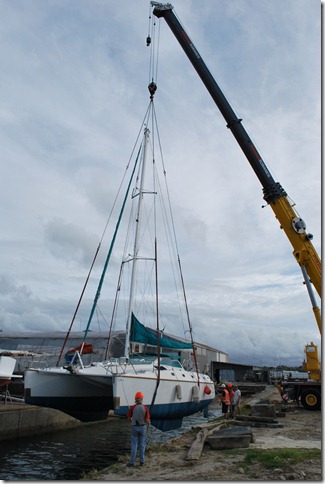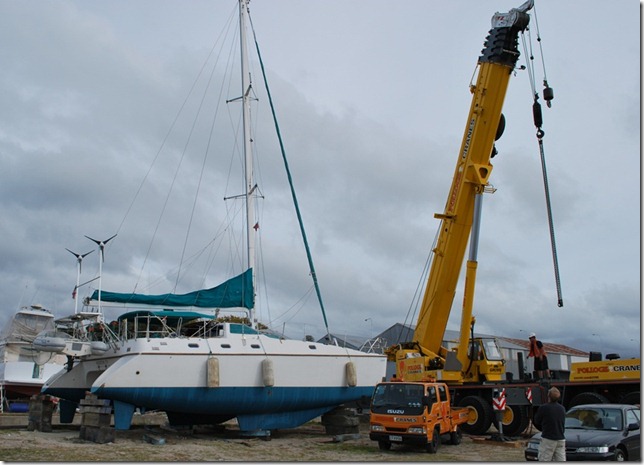After another long week of repairs, fairing, and sanding, the moment that seemed like it would never come finally arrived – it was time for Lauren to start applying the bottom paint to the repaired rudders and keel. By Sunday the final coat of paint was dry and we hoisted and blocked both rudders so we could reattach them to the steering mechanism and reconnect the autopilot. It was a great feeling to knock the last blocks of wood out from under the rudders then stand back and see the bottom job and repairs finally completed after 6 weeks.
We did a number of other repairs during the week as well – replacing a leaky hatch lens, replacing broken wind generator blades, re-bedding a leaking manual bilge pump, replacing broken hatch handles, re-doing the plumbing around the pressure water system, etc. The plumbing was a bit of a challenge, but we finally have a working system with both tanks plumbed independently through valves so that we can draw from only one tank at a time. Ever since we nearly pumped all of our fresh water out during the passage to NZ, I’d wanted to isolate the tanks so that if we did have a problem with one tank during a passage we’d still have the other full of water.
I’ve also been doing some research on the new SSB radio (Icom IC-M710RT with AT-130) we bought while I was in the states. It was a used eBay special at about half the price of a new unit, so I was anxious to see if it made the trip from the east coast to California and then from Los Angeles to Auckland without being damaged. It seems to be OK, although we’ll have to wait for the final installation before we can say for sure. The installation is a bit involved, but doing some research, I’ve decided to try doing my own antenna setup (save quite a bit over re-rigging one of our two cap shrouds as an isolated antenna) and install. Grounding is one of the biggest issues and I was able to find a nice long piece of copper at a scrap metal shop that will be ideal for grounding the antenna tuner to an unused metal through-hull. Finding a nice piece of copper was a bit of a chore, but the scrap metal shop was definitely the right place. After striking out at several places I’d been told would be good sources I headed back to the scrap shop that Martin and I had visited several months before. Not only did they have a long, thin piece of copper that we could cut to whatever size I wanted, but the sale was purely by weight, so we were able to cut exactly what I was looking for for only $15. If only all of our repairs ended with a $15 tab.
Monday was the big day – splash day. A 220 ton crane came out and after a short delay to get more line (it takes 20 meters plus the lifting straps to clear our mast), Pura Vida was airborne. The crane hook had a swivel, so we were able to spin the boat while it was in the air by pulling on some long lines and pushing on the hull by hand. That left us with our bow pointing toward the slipway entrance which made leaving easier than if we’d had to back out into the incoming tide. It was actually smooth enough that I didn’t get the usual jitters with the boat hanging in the air.
 After spinning the boat 180 degrees by hand, she was lowered into the slipway
After spinning the boat 180 degrees by hand, she was lowered into the slipway
Both engines started up and within minutes of being lowered into the slipway, we were motoring out into the river to check out the engines. We’ve been trying to diagnose a mysterious case of low oil pressure alarms on the port engine for a while now. After buying an oil pressure gauge and not being able to find any issues, we’d essentially concluded it was a faulty pressure alarm switch when the alarm went off as Lauren and Martin moved the boat to the yard 6 weeks ago. I found a bilge full of oil when I got back from the states, and it turns out the new oil pressure switch had signaled a real problem – loose fittings had allowed quite a bit of oil to leak out of the block and there actually was low oil pressure. Luckily, the engine hadn’t been run very long or hard with low oil pressure, and I was able to turn the engine over by hand with the decompression levers set, so I was optimistic that there wouldn’t be any long term issues. Other than a loose ground wire, we didn’t have any problems in the couple of hours we spent motoring about and waiting for slack tide to enter the marina, so we’re hopeful that maybe the oil pressure alarms are behind us.
We did venture out the channel and do a bit of sailing, and we were both surprised a bit by the motion. You get used to it when you’re dealing with it every day, but having been firmly planted on land for so long, we both felt the effects of it right away. Hopefully we’ll have decent weather for our passage north so we can ease back into being in motion all the time.
We don’t have a firm date yet, but it looks like the weather is going to be good for sailing farther north this weekend and by Monday we should be looking for a weather window to head to Fiji. Lauren put the car on Trademe (NZ version of eBay), and we already found a buyer for only $300 NZ less than what we paid for it. Given that it needs a $300 repair and we’ve owned it for about 5 months now, we definitely can’t complain. Two and a half more days and we’ll be car-less again and getting ready to make our way north.


